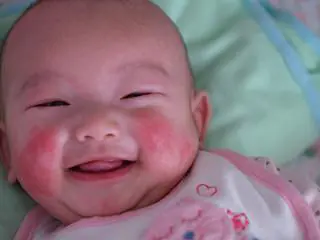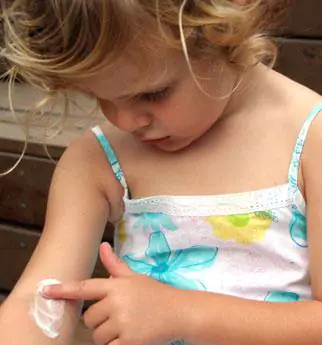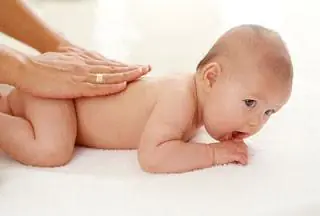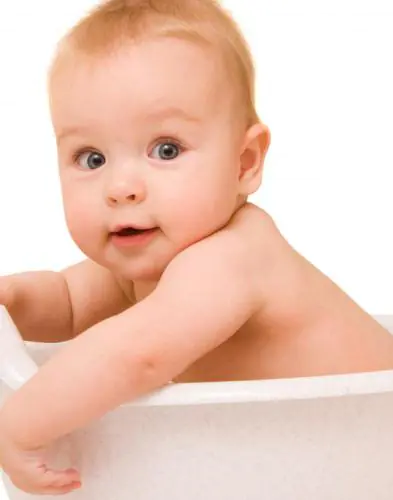The condition of a person's skin can tell a lot. Most of the diseases known to us have certain manifestations on the skin in the list of symptoms. Parents should pay attention to any changes, be it dry skin in the child, redness or peeling. Any deviation should prompt a visit to a specialist. All childhood diseases should be treated under the supervision of a doctor, timely access to whom will be the key to a successful recovery. Never delay or attempt treatment on your own. This can cause harm and significantly worsen the baby’s condition.

Why does a child develop dry skin?
The reasons are quite simple. A similar phenomenon occurs when there is not enough moisture in the stratum corneum. It may be supplied in insufficient quantities or may not bind. In both cases, dry skin can be observed. At first glance, such dehydration seems harmless. However, this is not at all true. Dry areas of the skin lose elasticity and become scaly and rough. But the worst thing is that small cracks appear in these places. Through them, pathogenic bacteria easily penetrate into the deep layers of the skin. As a result, dry skin in a child can cause dermatological diseases.
What to do first?
The skin of babies is different from that of adults. Its protective function is still poorly developed. Therefore, children are especially sensitive to external stimuli. If you notice that your child has dry, rough skin, then it is time to radically change your care system.

What should you pay attention to?
Dry, red skin in a child may be the result of a change in temperature or climate. Very often such deviations are observed in winter. Low temperatures and wind cause redness and irritation on the skin. In autumn and winter there is little moisture in the rooms due to central heating. This also negatively affects the condition of the skin.
What can be done?

Before going outside, lubricate your skin with a special cream or baby Vaseline. This will protect it from wind and cold in winter, and from sun rays in summer. This way you will help your baby avoid unpleasant rashes and dry skin. You can freshen the air in your apartment using special humidifiers. If there are none, just place containers of water in some places. By doing this you will be doing a great service to the whole family. You will certainly notice how much easier it has become to breathe.
Health care
If your child has very dry skin, take the time to see a doctor. Only a specialist can accurately determine the cause. This way you can start treatment on time and avoid serious consequences. The top layer of a child’s skin is not yet able to retain moisture in the required amount. In this case, it is necessary to compensate for it using various means and medications.

Drugs
Dry skin in a child very quickly becomes healthy under the influence of urea, or rather preparations containing it. They act in a special way, in two directions at once. First of all, urea is a natural humectant. It replenishes the lack of moisture in the stratum corneum and makes the skin smooth and elastic. In addition, urea penetrates deep into the skin and increases its ability to bind moisture. As a result of this effect, the moisture balance is leveled and the mechanism for self-supply with it is improved. The beneficial effects of drugs with urea do not end there. Thanks to them, itching, redness and irritation are significantly reduced.
How to choose a drug?
Only a doctor can answer the question of why a child has dry skin. However, you can choose the drug for treatment yourself. This requires a minimum set of knowledge. It is not enough to simply buy urea cream. It is very important to choose the right concentration and type of base. If the preparation contains 5% urea, then it is better to postpone it for the future. This cream can cause unpleasant and even painful sensations in the child.

Folk remedies
Dry skin in a child can be treated with traditional medicine. They can only be used in cases of mild injury and only after consulting a doctor. Baths with chamomile and rose petals are very useful in this case. The flowers are mixed in equal parts and poured with boiling water. They should be left to steep for about 20 minutes.
In the human body, the skin is one of the most important organs. It performs several functions at once: barrier, excretory, sensitive, thermoregulatory, storage and others. Therefore, parents should carefully monitor the condition of their baby’s skin from early childhood.
Normally, a child’s skin should be clean, smooth, without cracks or inflammation. If there are any changes on it (redness or roughness), parents should immediately pay attention to it. The child’s body signals that something has gone wrong.
If a child has dry skin, it means that the stratum corneum does not contain enough moisture. Its appearance changes - it becomes rough, wrinkled, sometimes even scaly, and loses elasticity. But that's not the worst thing. The danger lies in the fact that microcracks appear in dry skin, through which pathogenic bacteria easily penetrate into deeper layers and become the cause of the development of dermatological diseases.
Why does my baby have dry skin?
Dry skin in a child usually occurs in the first three years of life in the autumn-winter period or early spring. This phenomenon can be observed both on individual parts of the body (arms, legs, face) and on its entire surface. Children's skin is very sensitive to external factors, its protective function is just developing. Therefore, when dry spots or rashes appear on the body, it is important to determine which personal hygiene items may cause irritation of the epidermis, and exclude shampoos, soaps, gels, and washing powders to which the baby may be allergic. If your child has dry skin, you should choose only hypoallergenic hygiene and laundry products, preferably without a strong odor and bright color.
You should not bathe your baby in hot water, as it tends to dry the skin; the optimal temperature for this procedure is 37°C.
Sudden changes in temperature can also cause dry skin in a child. Severe frost and cold winds often cause irritation and redness on the face and hands. Therefore, before going outside, the baby needs to lubricate exposed areas of the body with a special cream.
Heating systems operating in winter dry out the air in apartments, so it is recommended to use special humidifiers during this period.
Dry skin in a child can be an allergic reaction of the body, so you should pay attention to food. Among them may be those that provoke allergies, in particular citrus fruits and chocolate.
Dry skin on a child's feet
Quite often, children have dry skin on their feet. Especially in the summer, it loses moisture to such an extent that it begins to crack and hurt. In this case, it is better to wear open shoes with maximum air access. To avoid dust and dirt getting into the cracks, you need to wear socks. Before going to bed, be sure to wash your baby’s feet with baby soap, wipe them dry and lubricate them with massaging movements with a special softening fortified cream.
Dry skin on a child's feet is highly susceptible to infections, which can lead to complications. The familiar heat rash, diaper dermatitis, and diaper rash spread quickly if not properly cared for, and a pustular rash can even form. To avoid complications, it is necessary to show the child to the doctor as soon as possible and begin treatment.
Treatment of dry skin in children
The epidermis in young children is not yet able to retain moisture in sufficient quantities, so it has to be replenished from the outside. The choice of moisturizer must be taken seriously, since the skin reacts sharply to external irritants. If the child has very dry skin, choose a product together with the pediatrician. Most often, in such cases, doctors recommend external preparations containing urea, in particular Excipial M lotion, as well as an additional course of vitamin A for a period of two months. It is better absorbed if you drop it on a small piece of black bread before eating. In some cases, if the baby’s skin is inflamed, vitamin E, calcium supplements, and fish oil are prescribed. The dose of medication is determined by the doctor.
It is better to bathe your child without foaming detergents at all. Herbal baths are very effective in such cases. You need to mix rose petals and chamomile flowers in equal proportions, pour boiling water over it and let it brew for 15-20 minutes. After this, strain and add to water. The procedure should last at least 10 minutes. A bath with flax oil is also effective (1 tablespoon will be enough).
After bathing, you can give your baby a massage, treating the skin with a cream containing vitamin A.
Dry skin of a child as a sign of the onset of the disease
Sometimes dry skin can indicate the onset of a disease. Therefore, if redness or irritation occurs, parents need to consult a doctor to make an accurate diagnosis, establish the cause and begin treatment. Dry skin in a child, mainly under the age of 1 year, often occurs with atopic dermatitis. Severely itchy, reddened areas are localized on the face, without affecting the nasolabial triangle.
Peeling and scaly formations on the elbows, knees, and cheeks may be signs of ichthyosis, a genetic disease in which the process of keratinization of cells in the body is disrupted.
If a child’s skin is very dry and peeling, most likely it is hypovitaminosis A and PP; treatment in the form of taking the necessary vitamins eliminates unpleasant symptoms.
It should be taken into account that dry skin can be caused by dehydration due to dyspeptic disorders (vomiting, diarrhea) and heavy sweating.
Dry spots on baby's skin
Dry spots on children's bodies often appear, and there is nothing unusual or scary about this, because she is very sensitive. But parents should be concerned if they do not go away for a long time. Firstly, the cause of such spots may be physiological, since in young children the fat glands are not yet fully functioning. Secondly, the condition of the skin is influenced by environmental factors (temperature and water hardness, air humidity, food, soap). At first, to soften the affected areas, you can use a product purchased at the pharmacy, for example, Panthenol. But if dry spots on the child’s skin do not disappear, you should consult a doctor, as they can be symptoms of serious diseases such as atopic dermatitis, eczema, and psoriasis.
Skin ailments are usually difficult to deal with, but a correct diagnosis made in time makes the task easier. If there are signs of a particular skin disease at an early age, it is very important to immediately take action and prevent its progression. Without proper treatment in a medical facility, it can become chronic.
Video from YouTube on the topic of the article:
Children's skin is like a litmus test: it instantly signals problems in the body and improper care. That is why it is so important to pay attention to any changes in her condition. Let's talk about how to develop an algorithm for caring for dry skin of babies.
- Main characteristics of healthy baby skin
- Causes of dry skin in children
- What does dry skin mean in a child?
- Dry skin on a child's feet
- How to eliminate dry skin
- Precautions for dry skin
- Rules for care at different times of the year
- Prevention measures
- Tools Overview
Main characteristics of healthy baby skin
Soft, delicate, velvety - this is how we usually talk about a baby’s skin. But even if the child is healthy, it does not become so immediately after birth.
Why? Explains Alexander Prokofiev, dermatovenerologist, medical expert at La Roche-Posay: “After the baby is born, his skin needs to adapt to the environment. In newborns, this process has not yet been completed, so their skin is more dry, more susceptible to irritation, redness, and easier to injure. These features disappear with age.”
Typically, by the age of two, the upper stratum corneum of the epidermis thickens, and the skin becomes more protected from external influences. The sebaceous and sweat glands begin to work more actively, and the process of thermoregulation gradually normalizes.”
Normally, a child’s skin should be pale pink and have good turgor, that is, be soft and elastic to the touch.
Bathing water should not be too hot © iStock
Causes of dry skin in children
“Children’s skin can become dry under the influence of both external and internal factors,” says Alexander Prokofiev. Let's list the external reasons.
Using detergents more than once a week, the water is too hard for bathing (it is better to pass it through a filter).
Exposure to the sun without protection
The baby’s skin is not able to resist the effects of UV rays, so children under one year old can be kept in the open sun for no more than five minutes a day, and even then “under the cover” of special baby creams with high SPF.
Dry indoor air and overheating
Overheated air is a test for a child’s imperfect thermoregulation system: the skin turns red, becomes hot, and irritation appears. The same thing happens if you wrap your baby up too much.
Cold air coming into contact with delicate baby skin can cause redness, dryness and irritation.
Internal factors may be due to:
poor nutrition, which is expressed in a lack of vitamins;
some diseases, primarily skin and endocrine;
What does dry skin mean in a child?
Very dry baby skin is a cause for concern. It is more vulnerable, easily injured, and damaged skin is more susceptible to infections, especially in infancy.
In addition, dryness may indicate the presence of:
ichthyosis (a disorder of keratinization of the skin, which manifests itself in the form of scale formation);
other diseases, including diabetes.
If dryness is a persistent feature of your child's skin, it makes sense to first consult with your pediatrician and then see a dermatologist for appropriate treatment.
Dry patches of skin on the child's face and body
Friction from shoes and clothing can also cause redness and flaking of baby's delicate skin. Sometimes the cause of hypersensitivity is the diseases mentioned above. In any case, choose clothes and shoes for your baby made from natural materials, and use children's hypoallergenic powders for washing. To prevent dry feet in summer, it is better to wear open-toed shoes.
How to eliminate dry skin
Use moisturizing creams, lotions or body milk made specifically for children's skin. On such products it is always written what age they are intended for.
The water for bathing the baby should not be hot. The optimal temperature for the bath is 36–37 degrees.
Bathe your child every day, but use detergents no more than once a week. Choose special delicate formulas for this.
Moisturize dry areas with baby cream, milk or lotion.
An important condition against dry skin in children is the drinking regime © iStock
Precautions for dry skin
Dry skin brings a lot of anxiety to a child. It itches, itches, flakes - all this causes moodiness and bad mood. What can parents do in this situation? First of all, eliminate any factors that provoke dry skin of the baby.
It is not advisable to use soap when bathing and washing your face; it dries out the skin.
Sponges made from rough materials are also harmful. Washing should be as gentle as possible.
Do not wrap your baby while walking to avoid sweating.
Do not self-medicate. If dry skin persists, consult a doctor.
Rules for care at different times of the year
A child's skin needs protection in both heat and cold.
Remember that you should not be in the sun during the hottest time, from 11 a.m. to 4 p.m. On the beach, be sure to wear a T-shirt and a Panama hat on your baby, and use children's sunscreen. When you return from a walk, wash off the SPF cream and apply a moisturizer to your skin.
Exposure to cold and dry indoor air contributes to excessive dryness of the skin. Install a humidifier in your home or regularly cover the radiators with a wet towel. Moisturize your baby's skin after bathing.
Prevention measures
To avoid dry skin, offer your child something to drink often. Make sure there are enough vitamins in his diet. Moisturize your baby's skin after bathing. In your care, use only hypoallergenic products tested by dermatologists.
The creams should include moisturizing and soothing components: panthenol, niacinamide, oils (shea, olive, wheat germ), zinc oxide, vitamins A, B, E, F, plant extracts (chamomile, calendula, string).
Tools Overview
Milk for very dry skin Lipikar Lait, La Roche-Posay
Formula with shea butter, thermal water and niacinamide nourishes the skin and restores its lipid barrier. Suitable for use in infants, children and adults.
Skin cleansing gel Lipikar Gel Lavant, La Roche-Posay
Contains shea butter and niacinamide and is free of fragrance and parabens. Has skin-soothing properties, suitable for the whole family.



